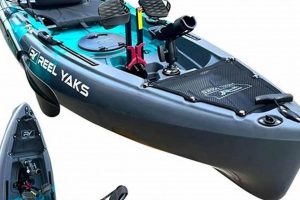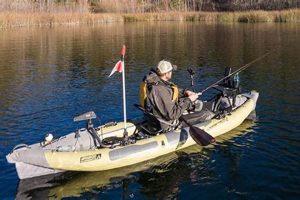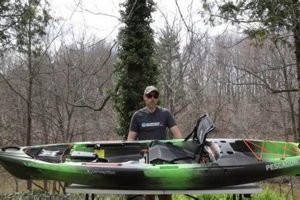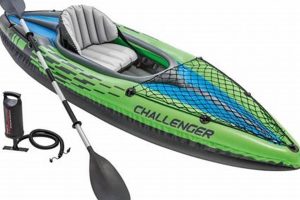A top-tier, human-powered watercraft designed for angling offers stability, specialized features, and maneuverability ideal for navigating various aquatic environments. These vessels often include features like rod holders, gear tracks, and ample storage for tackle and equipment, enhancing the fishing experience. Choosing a suitable model depends on factors such as water conditions (calm lakes vs. flowing rivers), angler size and weight, desired fishing style, and budget.
Optimized watercraft for anglers provides significant advantages over generic kayaks or other small boats. Their inherent stability reduces the chance of capsizing while casting or reeling in fish. Dedicated storage and mounting options keep essential gear organized and readily accessible, improving efficiency and enjoyment. Furthermore, their maneuverability allows access to shallow waters and tight spots often teeming with fish but inaccessible to larger vessels. The evolution of these specialized boats reflects a growing demand for comfortable and efficient angling platforms, tailored to specific fishing needs and environments.
The following sections will explore key factors to consider when selecting a fishing kayak, including hull design, propulsion systems, materials, essential features, and popular models available in the market. This information will empower anglers to make informed decisions, ensuring they choose the vessel best suited to their individual requirements and angling aspirations.
Tips for Selecting an Optimal Fishing Kayak
Choosing the right fishing kayak requires careful consideration of various factors to ensure optimal performance, stability, and comfort. The following tips offer guidance for selecting a vessel tailored to individual angling needs and preferences.
Tip 1: Consider Hull Design: Hull design significantly impacts stability and maneuverability. A wider, flatter hull offers superior stability, ideal for calm waters and stand-up fishing. A narrower, V-shaped hull provides better tracking and speed, suitable for covering longer distances and paddling in currents.
Tip 2: Evaluate Propulsion Systems: Paddle kayaks offer excellent maneuverability and affordability. Pedal-driven kayaks allow hands-free fishing and faster speeds. Motorized kayaks provide the greatest range and speed but require more maintenance and are often heavier.
Tip 3: Assess Material and Weight Capacity: Consider the kayak’s material (polyethylene, fiberglass, or composite) for durability and weight. Ensure the weight capacity accommodates the angler’s weight, gear, and potential catch.
Tip 4: Prioritize Essential Features: Look for features like rod holders, gear tracks, adjustable seating, and ample storage compartments for tackle and equipment. These features enhance fishing efficiency and comfort.
Tip 5: Research and Compare Models: Research various models and compare their features, specifications, and user reviews to identify the best fit for individual needs and budget.
Tip 6: Test Before Purchasing (If Possible): Testing a kayak before purchase allows anglers to assess its stability, comfort, and handling characteristics firsthand.
Tip 7: Consider Water Conditions: Choose a kayak suitable for the intended fishing environment. A shorter, more maneuverable kayak is ideal for navigating tight creeks and rivers, while a longer, more stable kayak is better suited for open lakes and coastal areas.
By carefully considering these factors, anglers can choose a vessel optimized for their specific fishing style, ensuring a comfortable, efficient, and enjoyable experience on the water. This informed approach contributes to successful outings and maximizes angling opportunities.
Ultimately, the selection process revolves around finding the perfect balance between stability, maneuverability, features, and budget. The subsequent section will explore some top-rated fishing kayaks currently available in the market.
1. Stability
Stability is a paramount consideration when selecting a fishing kayak, directly impacting safety and angling effectiveness. A stable platform allows anglers to cast, reel, and land fish without compromising balance, especially crucial when handling larger catches or navigating challenging water conditions. This section explores key facets of stability relevant to optimal kayak design.
- Hull Design and Stability
Hull design significantly influences stability. Wider, flatter hulls provide greater initial stability, making them ideal for calm waters and stand-up fishing. However, they can be slower and less maneuverable than narrower hulls. Conversely, V-shaped hulls offer better tracking and speed but sacrifice some initial stability. Pontoon-style hulls offer exceptional stability, particularly beneficial for anglers who prefer to stand while fishing.
- Center of Gravity and Weight Distribution
A lower center of gravity contributes to enhanced stability. Proper weight distribution within the kayak further optimizes balance. Storing heavier items low and centrally improves stability. The angler’s position also plays a role; sitting or standing upright generally provides better balance than leaning to one side. Kayaks designed with a wider beam (width) inherently offer a lower center of gravity, improving stability.
- Impact of Water Conditions on Stability
Calm waters present fewer stability challenges compared to rough conditions or strong currents. Wind, waves, and currents can significantly impact stability, particularly in kayaks with less stable hull designs. Anglers should choose a kayak with sufficient stability for the anticipated water conditions. For example, a kayak intended for ocean fishing requires greater stability than one designed for calm lakes.
- Stability Enhancements and Features
Features like outriggers and stabilizers can enhance stability, particularly for anglers who prioritize stand-up fishing. Some kayaks offer adjustable seating positions, allowing anglers to fine-tune their center of gravity for optimal balance. Wider, flatter decks provide more room to move around without compromising stability.
Ultimately, selecting a fishing kayak with appropriate stability ensures angler safety and enhances fishing effectiveness. Carefully considering hull design, weight distribution, anticipated water conditions, and available stability enhancements contributes to informed decision-making and a positive on-the-water experience. Prioritizing stability allows anglers to focus on fishing rather than maintaining balance, contributing to a more successful and enjoyable outing.
2. Maneuverability
Maneuverability represents a critical performance attribute in fishing kayaks, directly influencing an angler’s ability to navigate diverse water environments and access prime fishing locations. A highly maneuverable vessel allows for efficient exploration of shallows, swift navigation through tight waterways, and precise positioning in challenging conditions. This section examines key facets contributing to optimal maneuverability in the context of fishing kayaks.
- Hull Design and Length
Hull design significantly impacts maneuverability. Shorter kayaks generally offer greater maneuverability, enabling tighter turns and quicker responsiveness to paddle input. Longer kayaks, while offering better tracking and speed in open water, may prove less agile in confined spaces or when navigating complex shorelines. A kayak’s length should align with the intended fishing environment; shorter kayaks are preferable for navigating creeks and rivers, while longer kayaks may be better suited for larger lakes or open water.
- Width and Turning Radius
Kayak width influences turning radius. Narrower kayaks generally exhibit a tighter turning radius, allowing for sharper turns and more precise maneuvering. Wider kayaks, while providing enhanced stability, may require more effort and space to turn effectively. The optimal width depends on the balance between desired stability and maneuverability.
- Tracking and Stability Influences
While maneuverability is crucial, it must be balanced with adequate tracking and stability. A kayak that turns too easily may be difficult to control in windy or choppy conditions. Hull design features like keels or fins can improve tracking and directional stability, reducing the tendency to drift off course. The ideal balance between maneuverability and stability depends on the intended fishing environment and angler preferences.
- Propulsion System Impact
Paddle kayaks offer excellent maneuverability due to direct paddle control. Pedal-driven kayaks allow hands-free fishing but may have a slightly wider turning radius compared to paddle kayaks. Motorized kayaks, while providing greater speed and range, may sacrifice some maneuverability, especially in tight spaces. The choice of propulsion system depends on factors like fishing style, physical capabilities, and desired range.
In conclusion, maneuverability plays a vital role in fishing kayak performance, enabling anglers to efficiently explore various waterways and access productive fishing areas. Careful consideration of hull design, length, width, and propulsion system allows for selection of a kayak optimized for specific fishing environments and angling techniques. Finding the optimal balance between maneuverability, stability, and tracking ensures a productive and enjoyable fishing experience.
3. Storage Capacity
Ample and well-designed storage is a defining characteristic of a high-quality fishing kayak. Efficient organization and accessibility of essential gear, including tackle boxes, rods, safety equipment, and personal items, directly impacts both angling success and overall enjoyment on the water. Insufficient storage capacity can lead to cluttered decks, hindering movement and potentially compromising safety. This section explores crucial facets of storage capacity within the context of fishing kayaks.
- Types of Storage Compartments
Fishing kayaks typically offer a variety of storage options, including front and rear hatches, tank wells, side pockets, and dedicated compartments for specific items like rods and paddles. Hatches provide secure, waterproof storage for larger items, while tank wells offer quick access to frequently used gear. Side pockets are convenient for smaller items like pliers, knives, and sunscreen. Specialized compartments ensure rods and paddles are securely stowed and readily accessible. The availability and configuration of these storage options should align with the angler’s specific needs and fishing style.
- Storage Capacity and Weight Capacity
Storage capacity must be considered in conjunction with the kayak’s overall weight capacity. Overloading a kayak can compromise stability and performance. Anglers should carefully assess their gear requirements and choose a kayak with a weight capacity that accommodates their body weight, all essential equipment, and potential catches. Weight distribution within the kayak is also crucial for maintaining balance and stability. Distributing weight evenly throughout the various storage compartments helps optimize performance and prevents the kayak from becoming unbalanced.
- Accessibility and Organization
Easy access to stored gear is paramount for efficient fishing. Well-designed hatches and compartments should be readily accessible from the seated position, minimizing the need to reach or shift body weight. Features like tackle organizers, gear tracks, and bungee cords contribute to efficient organization and prevent gear from shifting during transit. The arrangement and layout of storage compartments should prioritize quick and convenient access to essential items.
- Material and Durability of Storage Compartments
Storage compartments should be constructed from durable, waterproof materials to protect gear from the elements. Hatches should seal tightly to prevent water intrusion, even in challenging conditions. Durable latches and hinges ensure reliable closure and prevent accidental opening during transport or use. The quality and durability of storage compartments contribute to the overall longevity and performance of the fishing kayak.
In summary, adequate and well-designed storage is an essential element of a premium fishing kayak. The availability of diverse storage options, sufficient capacity, ease of access, and durable construction contribute significantly to angling efficiency, organization, and overall enjoyment on the water. Prioritizing storage considerations ensures a well-equipped and streamlined fishing experience, allowing anglers to focus on the pursuit of their target species rather than managing gear or contending with limited space.
4. Comfort and Ergonomics
Comfort and ergonomics represent critical factors influencing the overall fishing experience, particularly during extended outings on the water. A well-designed fishing kayak prioritizes these elements to minimize fatigue, maximize angling efficiency, and prevent potential physical discomfort or injury. An uncomfortable or poorly designed kayak can detract significantly from the enjoyment of fishing and limit an angler’s time on the water. The connection between comfort, ergonomics, and optimal kayak design is explored further below.
Adjustable seating systems are paramount for achieving optimal comfort and ergonomic positioning. Features like adjustable backrests, foot braces, and thigh supports allow anglers to customize their seating position to accommodate individual body types and preferences. Proper posture and support minimize strain on the back, legs, and core muscles, allowing for extended periods of comfortable fishing. For example, an angler targeting offshore species might spend hours on the water; a comfortable and adjustable seating system becomes essential to prevent fatigue and maintain focus throughout the fishing session.
Padding and breathability also contribute significantly to comfort. High-quality padding in the seat and backrest enhances cushioning and support, while breathable materials promote ventilation and prevent overheating. This is particularly important in warmer climates or during strenuous paddling sessions. Consider an angler fishing in a tropical environment; a breathable seat can significantly improve comfort and prevent discomfort caused by excessive heat and perspiration. Furthermore, well-placed padding in high-contact areas, such as the seat and thigh braces, minimizes pressure points and enhances overall comfort.
Ergonomic design extends beyond seating to encompass other aspects of the kayak, such as paddle placement, gear accessibility, and deck layout. Paddle holders and strategically placed gear tracks allow anglers to keep essential equipment within easy reach, minimizing awkward movements and promoting efficient fishing practices. A well-designed deck layout provides ample space for movement and comfortable positioning of legs and feet, further enhancing comfort and reducing fatigue. Addressing these ergonomic considerations contributes to a more seamless and enjoyable fishing experience.
5. Durability and Construction
Durability and construction represent paramount considerations when selecting a fishing kayak, directly impacting its longevity, performance, and ability to withstand the rigors of diverse aquatic environments. A robust and well-constructed kayak ensures reliable performance over time, minimizing the risk of damage and maximizing the return on investment. Understanding the nuances of kayak construction empowers informed decision-making and contributes to a positive long-term ownership experience. This section explores key facets of durability and construction within the context of premium fishing kayaks.
- Material Selection and Impact on Durability
Kayak construction materials significantly influence overall durability. Common materials include polyethylene (rotational molding or thermoforming), fiberglass, and composites (carbon fiber, Kevlar). Polyethylene offers excellent impact resistance and affordability, making it a popular choice for recreational kayaks. Fiberglass provides a balance of durability, performance, and lighter weight, while composites offer the highest strength-to-weight ratio but come at a premium cost. Material choice impacts not only durability but also weight, performance characteristics, and price point. For instance, a kayak designed for rocky river environments would benefit from the high impact resistance of rotomolded polyethylene, while a kayak intended for open ocean paddling might prioritize the lightweight performance of a composite construction.
- Hull Construction Techniques and Structural Integrity
Hull construction techniques play a crucial role in determining a kayak’s structural integrity. Rotational molding creates a single-piece, seamless hull with excellent durability. Thermoforming involves shaping sheets of plastic over a mold, resulting in a lighter but potentially less impact-resistant hull. Fiberglass and composite kayaks are typically constructed using a layering process that creates a strong and stiff structure. Understanding the different construction techniques informs the selection process and ensures alignment with specific durability and performance requirements. For example, a kayak designed for navigating shallow, rocky areas would benefit from the robust, single-piece construction offered by rotational molding.
- UV Resistance and Long-Term Degradation Prevention
Exposure to ultraviolet (UV) radiation from sunlight can degrade kayak materials over time, leading to fading, cracking, and reduced structural integrity. High-quality kayaks incorporate UV inhibitors in their construction to mitigate the effects of sun exposure. Proper storage and maintenance practices, such as covering the kayak when not in use, further contribute to long-term protection and preservation. Selecting a kayak with robust UV resistance safeguards the investment and ensures long-lasting performance in various environments.
- Hardware and Fittings: Quality and Corrosion Resistance
The quality and corrosion resistance of hardware and fittings, such as handles, latches, and deck rigging, are essential for overall durability and functionality. Marine-grade stainless steel or other corrosion-resistant materials ensure long-term performance in harsh saltwater environments. Well-designed and securely attached fittings contribute to the overall structural integrity and prevent premature wear or failure. For example, a saltwater fishing kayak demands high-quality, corrosion-resistant hardware to withstand the corrosive effects of saltwater exposure.
In conclusion, durability and construction are fundamental aspects of a premium fishing kayak. Careful consideration of material selection, construction techniques, UV resistance, and hardware quality ensures long-lasting performance, resilience in diverse environments, and a positive ownership experience. Prioritizing durability empowers anglers to focus on fishing with confidence, knowing their vessel can withstand the demands of their chosen angling pursuits.
6. Specialized Features (e.g., rod holders)
Specialized features distinguish a purpose-built fishing kayak from a standard recreational model. These features enhance angling efficiency, organization, and overall on-the-water experience. A best-in-class fishing paddle kayak incorporates thoughtful design elements that cater specifically to the needs of anglers. The following facets illustrate the significance of specialized features in optimizing fishing kayak functionality and performance.
- Rod Holders
Rod holders are fundamental components of a fishing kayak, providing secure storage and convenient access to fishing rods. Multiple rod holders, strategically positioned for different fishing techniques (trolling, casting, etc.), allow anglers to carry multiple rods rigged for various target species or fishing styles. Flush-mounted rod holders minimize interference with paddling and casting, while adjustable rod holders offer flexibility in positioning rods at optimal angles. For example, an angler targeting different species might carry one rod rigged for trolling and another for casting; dedicated rod holders accommodate both setups without entanglement or interference.
- Gear Tracks and Mounting Systems
Gear tracks and mounting systems offer versatile platforms for attaching accessories like fish finders, GPS units, cameras, and other electronic devices. These systems provide standardized mounting points, allowing anglers to customize their kayak setup to suit individual preferences and fishing styles. Modular mounting systems allow for easy adjustment and repositioning of accessories, optimizing ergonomics and functionality. For example, a kayak angler utilizing a fish finder can mount the device within easy view and reach, enhancing situational awareness and maximizing fishing efficiency.
- Storage and Organization Solutions
Specialized storage solutions, such as tackle compartments, dry bags, and integrated storage hatches, are essential for maintaining organization and protecting gear from the elements. Dedicated tackle compartments keep lures, hooks, and other small items readily accessible and prevent them from becoming tangled or lost. Dry bags protect sensitive electronics and personal items from water damage. Well-designed storage hatches offer secure and waterproof storage for larger items like tackle boxes and safety gear. For instance, a kayak angler targeting specific species can organize lures and tackle within dedicated compartments, facilitating quick changes and optimizing fishing time.
- Specialized Seating and Comfort Features
Comfort features contribute significantly to the overall fishing experience. Adjustable seating systems, breathable fabrics, and ample padding minimize fatigue and enhance comfort during long hours on the water. Elevated seating positions offer improved visibility and casting angles. Footrests and thigh braces provide additional support and stability, enhancing paddling efficiency and overall comfort. Consider an angler fishing in challenging conditions; a comfortable and supportive seating system allows them to maintain focus and effectively fish for extended periods, even in demanding environments.
In summary, specialized features are essential components of a best-in-class fishing paddle kayak. These features contribute to enhanced angling efficiency, optimized organization, and improved comfort on the water. Rod holders, gear tracks, specialized storage, and comfort-focused design elements collectively elevate the fishing experience and allow anglers to maximize their time and success on the water. The integration of these specialized features ultimately distinguishes a dedicated fishing kayak from a standard recreational model, demonstrating a focus on performance, functionality, and angler-centric design.
Frequently Asked Questions
This section addresses common inquiries regarding the selection and use of high-performance fishing kayaks designed for paddling.
Question 1: How does hull design impact stability and maneuverability in a fishing kayak?
Wider, flatter hulls offer greater initial stability, ideal for calm water and stand-up fishing. Narrower, V-shaped hulls enhance speed and tracking in open water but sacrifice some stability. Shorter kayaks generally offer greater maneuverability in tight spaces, while longer kayaks track better in open water.
Question 2: What are the key advantages of a pedal-driven fishing kayak over a paddle kayak?
Pedal drives allow hands-free fishing and offer faster speeds compared to paddling. This enables anglers to cover more water and focus on fishing rather than propulsion. Pedal kayaks also offer greater power and control in challenging conditions like currents or wind.
Question 3: What factors determine appropriate weight capacity in a fishing kayak?
Weight capacity should accommodate the angler’s weight, all fishing gear, and any potential catch. Exceeding the weight capacity can compromise stability and performance. Choosing a kayak with ample weight capacity ensures safe and efficient operation.
Question 4: What essential features should one look for in a fishing kayak for optimal performance?
Essential features include multiple rod holders, gear tracks for mounting accessories, ample storage compartments, comfortable seating with adjustable features, and a durable, stable hull design. Features like rudders or skegs enhance tracking and control.
Question 5: How does one choose between a sit-on-top and a sit-inside fishing kayak?
Sit-on-top kayaks offer greater stability, easier entry and exit, and better self-rescue capabilities. Sit-inside kayaks provide better protection from the elements and offer a drier ride, particularly in colder conditions. The choice depends on personal preference, intended use, and the prevailing climate.
Question 6: How does one maintain a fishing kayak to ensure its longevity and performance?
Regular cleaning, proper storage (out of direct sunlight), and periodic inspection of hardware and fittings are crucial for maintaining a fishing kayak. Rinsing the kayak with fresh water after each use, especially in saltwater environments, prevents corrosion and damage. Proper storage practices protect the kayak from UV degradation and other environmental factors.
Addressing these frequently asked questions aims to provide comprehensive insights into selecting, using, and maintaining premium fishing kayaks, empowering informed decisions and maximizing angling experiences.
The next section will offer a concluding overview of key considerations and recommendations for choosing the ideal fishing kayak based on individual needs and preferences.
Conclusion
Optimal selection hinges upon a comprehensive understanding of individual angling needs, target species, and prevailing water conditions. Careful consideration of hull design, material construction, storage capacity, specialized features, and overall comfort ensures a harmonious balance between stability, maneuverability, and functionality. Prioritizing these elements empowers anglers to choose a vessel that enhances on-the-water performance and contributes to a more productive and enjoyable fishing experience. Dedicated research and thoughtful evaluation of these critical factors are essential for informed decision-making.
Ultimately, an informed acquisition of a premium, human-powered fishing watercraft represents an investment in long-term angling enjoyment and success. A vessel tailored to specific needs empowers anglers to explore diverse waterways, access prime fishing locations, and pursue target species with confidence and efficiency. Choosing wisely unlocks the full potential of kayak fishing, enriching the angling experience and fostering a deeper connection with the aquatic environment.






